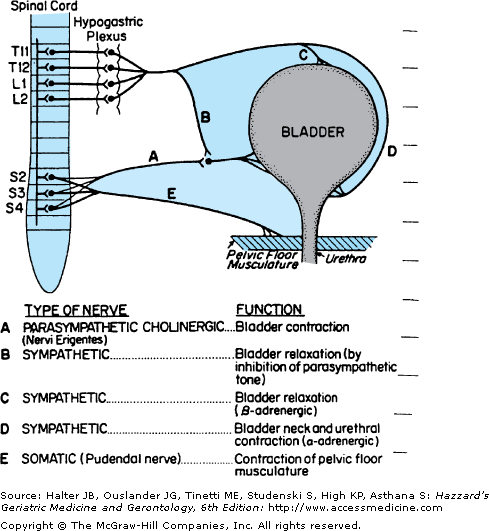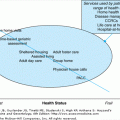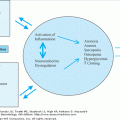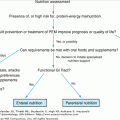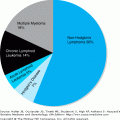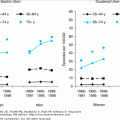Definition and Epidemiology
Defined as the complaint of any involuntary leakage of urine, urinary incontinence is a common and bothersome condition in elderly persons. The prevalence of incontinence increases with age and with increasing frailty, and is 1.3 to 2.0 times greater in older women than in older men. Among community-dwelling older women, the prevalence of any urinary incontinence is approximately 35%; among older men, it is approximately 22%. The prevalence of daily urinary incontinence in older community-dwelling persons is approximately 12% for women and 5% for men. The prevalence approaches 60% among nursing home residents. Incontinence ranges in severity from occasional episodes of dribbling small amounts of urine to continuous urine leakage with concomitant fecal incontinence. In addition, many older people who do not “leak urine” still may have bothersome lower urinary tract symptoms such as urgency, frequency, and nocturia that require changes in lifestyle and/or the use of pads.
Physical health, psychological well-being, social status, and the costs of health care can all be adversely affected by incontinence. Urinary incontinence can be cured or greatly improved, especially in those who have adequate mobility and mental functioning. Even when not curable, incontinence can always be managed to allow for more patient comfort, make life easier for caregivers, and minimize costs of caring for the condition. Because many elderly patients are embarrassed to discuss their incontinence and may not be aware that treatment is available, it is essential for specific questions about incontinence to be included in periodic assessments and for incontinence to be noted as a problem (Table 59-1). This chapter briefly reviews the pathophysiology of incontinence in older persons and provides detailed information on the evaluation and management of this condition.
Questions about incontinence should be open-ended and phrased in language easily understood by the patient: |
“Tell me about any problems you are having with your bladder?” |
“Tell me about any trouble you are having holding your urine (water)?” |
If the responses to the above questions are negative, following up with questions may be helpful: |
“How often do you lose urine when you don’t want to?” |
“How often do you wear a pad or other protective device to prevent urinary accidents?” |
Pathophysiology and Classification
Continence requires effective functioning of the lower urinary tract, adequate cognitive and physical functioning, motivation, and an appropriate environment (Table 59-2). Anatomic and physiologic aspects of the lower urinary tract, as well as functional, psychological, and environmental factors, contribute to the pathophysiology of incontinence in older persons. Normal urination is a complex process; the neurophysiology of urination remains incompletely understood. Proper bladder filling and emptying are influenced by higher centers in the brainstem, cerebral cortex, and cerebellum. The brainstem facilitates urination and the cerebral cortex exerts a predominantly inhibitory influence. Additionally, the loss of the central cortical inhibitory influences over the sacral micturition center from diseases such as stroke can produce incontinence in older patients. Even in the absence of specific, overt neurological lesions, poor bladder control has been shown to be associated with inadequate activation of the orbitofrontal cortex. Disorders of the brainstem and suprasacral spinal cord can interfere with the coordination of bladder contraction and urethral relaxation. Interruptions of the sacral innervation can cause impaired bladder contraction and problems with continence.
Effective lower urinary tract function |
Storage |
Accommodation by bladder of increasing volumes of urine under low pressure |
Closed bladder outlet |
Appropriate sensation of bladder fullness |
Absence of involuntary bladder contractions |
Emptying |
Bladder capable of contraction |
Lack of anatomic obstruction to urine flow |
Coordinated lowering of outlet resistance with bladder contractions |
Adequate mobility and dexterity to use toilet |
Adequate cognitive function to recognize toileting needs |
Motivation to be continent |
Absence of environmental and iatrogenic barriers |
At the most basic level, urination is governed by a reflex centered in the sacral micturition center. During normal bladder filling, afferent pathways (via somatic and autonomic nerves) carry information on bladder volume to the spinal cord. Motor output is adjusted accordingly (Figure 59-1). Sympathetic tone closes the bladder neck and inhibits parasympathetic tone (thus relaxing the dome of the bladder); somatic innervation maintains tone in the pelvic floor musculature (including striated muscle around the urethra). Voluntary pelvic floor muscle contracture also leads to inhibition of parasympathetic tone. For bladder emptying, sympathetic and somatic tones diminish, and parasympathetic, cholinergically-mediated impulses cause the bladder to contract. Normal urination is a dynamic process, requiring the coordination of several physiologic processes. Under normal circumstances, as the bladder fills, bladder pressure remains low (≤15 cm H2O). The bladder volume at first urge to void is variable, but generally occurs at between 150 and 350 mL; normal bladder capacity is 300 to 600 mL. When normal urination is initiated, the detrusor contracts and detrusor pressure increases until it exceeds urethral resistance (which lowers immediately prior to bladder contraction). Urine flow occurs. If at any time during bladder filling, total bladder pressure exceeds outlet resistance, urinary leakage occurs. Transmitted intra-abdominal pressure alone by coughing or sneezing may cause leakage in someone with low outlet resistance pressure or urethral sphincter weakness. Alternatively, the bladder can contract involuntarily and cause urinary leakage.
Urologic, neurologic, psychological, and functional factors may contribute to incontinence. As is the case for a number of other common geriatric problems, multiple disorders often interact to cause urinary incontinence. Determining the cause or causes facilitates proper management. Overall, aging is associated with increasing incontinence. The prevalence of stress incontinence likely does not increase in women, while the prevalence of urge incontinence and mixed stress–urge incontinence does increase.
Several age-related changes can contribute to the development of urinary incontinence. In general, residual urine volume following voiding is greater with increasing age. While a decline in functional bladder capacity has been associated with advanced age, this may be because of the higher prevalence of involuntary bladder contractions and detrusor overactivity in older persons. Involuntary bladder contractions are found in 40% to 75% of elderly incontinent patients, but also in 5% to 10% of elderly continent women and in up to one-third of elderly men with no or minimal urinary symptoms. Detrusor overactivity has been associated with specific anatomical findings (protrusion junctions and ultra-close abutment of detrusor muscle cells) on bladder biopsy. While involuntary bladder contractions do not always result in urinary incontinence, when combined with impaired mobility, these contractions likely account for a substantial proportion of incontinence in elderly functionally disabled patients. Aging is also associated with a decline in bladder outlet and urethral resistance pressure in women. While there is a recognition that laxity of pelvic structures associated with prior childbirths (either via vaginal deliveries or Caesarean section) may result in a greater risk of future incontinence, the association between parity and incontinence is weak in women older than 65 years. Additionally, in older populations, poor vaginal support is more closely associated with obstructive urinary symptoms than with urinary leakage and urgency. Obesity, deconditioned muscles, and hysterectomy predispose women to future development of incontinence. Racial or ethnic characteristics are likely important; white women are more likely, as a group, to have stress urinary incontinence than are African-American women.
Older men with prostatic enlargement may have decreased urine flow rates and detrusor motor instability. Aging is also associated with higher rates of nocturia, which may in part be related to higher urine production at night (see Chapter 88). Many older individuals of both genders have impaired bladder contractility, often in combination with detrusor hyperactivity (a condition termed detrusor hyperactivity with impaired contractility, or DHIC). These individuals have evidence of widespread muscle degeneration on detrusor muscle biopsy.
The distinction between acute (or reversible) forms of incontinence and persistent (or established) incontinence is clinically important although not always distinct. Acute incontinence refers to those situations in which the incontinence is of sudden onset, usually related to an acute illness or an iatrogenic problem, and subsides once the illness or medication problem has been resolved. Persistent incontinence refers to incontinence that is unrelated to an acute illness and persists over time. Several of the reversible factors discussed below also can contribute to persistent forms of incontinence.
The potentially reversible causes of urinary incontinence are outlined in Table 59-3. These causes include impaired ability (or willingness) to reach a toilet, conditions that affect the lower urinary tract, conditions that cause or contribute to polyuria, and iatrogenic factors. Because of urinary frequency and urgency, many older persons, especially those limited in mobility, carefully arrange their schedules (and may even limit social activities) in order to be close to a toilet. Thus, an acute illness can precipitate incontinence by disrupting this delicate balance. Hospitalization, with its attendant environmental barriers (such as bed rails), and the delirium and immobility that often accompany acute illnesses in older patients can contribute to acute incontinence. Acute incontinence in these situations is likely to resolve with resolution of the underlying acute illness. In a substantial proportion of patients, incontinence may persist for several weeks after hospitalization and should be further evaluated.
CONDITION | MANAGEMENT |
|---|---|
Conditions affecting the lower urinary tract | |
Urinary tract infection (symptomatic with frequency, urgency, dysuria, etc.) | Antimicrobial therapy (not for asymptomatic bacteriuria) |
Atrophic vaginitis/urethritis | Topical estrogen |
Postprostatectomy (incontinence will often resolve during first yr) | Behavioral interventions Avoid further surgical therapy until it is clear condition will not resolve |
Stool impaction | Disimpaction; appropriate use of stool softeners, bulk-forming agents, and laxatives if necessary; implement high fiber intake, adequate mobility and fluid intake |
Drug side effects (see Table 59-4) | |
Discontinue or change therapy if clinically appropriate. Dosage reduction or modification (e.g., flexible scheduling of rapid-acting diuretics) may also help | |
Increased urine production | |
Metabolic (hyperglycemia, hypercalcemia) | Better control of diabetes mellitus; therapy for hypercalcemia depends on underlying cause |
Excess fluid intake | Reduction in intake of diuretic fluids (e.g., caffeinated beverages) |
Volume overload | |
Venous insufficiency with edema | Support stocking Leg elevation Sodium restriction Diuretic therapy |
Congestive heart failure | Medical therapy |
Impaired ability or willingness to reach a toilet | |
Delirium | Diagnosis and treatment of underlying cause(s) delirium (see Chapter 53) |
Chronic illness, injury, or restraint that interferes with mobility | |
Regular toileting | |
Use of toilet substitutes | |
Environmental alterations (e.g., bedside commode, urinal) | |
Psychological | Remove restraints if possible |
Appropriate pharmacologic and/or nonpharmacologic treatment |
Fecal impaction is a common problem in both acutely and chronically ill elderly patients. Impaction may cause mechanical obstruction of the bladder outlet that can prevent adequate bladder emptying and cause reflex bladder contractions induced by rectal distension. Relief of a fecal impaction can lead to resolution of urinary, as well as fecal, incontinence. Urinary incontinence with a high postvoid residual should be considered in any patient who suddenly develops urinary incontinence. Immobility; anticholinergic, narcotic, calcium channel blocking, and beta adrenergic medications (Table 59-4); and fecal impaction can all precipitate incontinence with a high postvoid residual in an older patient. In addition, urinary retention may be an acute manifestation of an underlying process causing spinal cord compression or occur after a stroke.
TYPE OF MEDICATION | POTENTIAL EFFECTS ON CONTINENCE |
|---|---|
Diuretics | Polyuria, frequency, urgency |
Anticholinergics | Urinary retention, overflow incontinence, stool impaction |
Psychotropics | |
Antidepressants | Anticholinergic actions, sedation |
Antipsychotics | Anticholinergic actions, sedation, immobility |
Sedative–hypnotics | Sedation, delirium, immobility, urethral muscle relaxation |
Narcotic analgesics | Urinary retention, fecal impaction, sedation, delirium |
Alpha adrenergic blockers | Urethral relaxation |
Alpha adrenergic agonists | Urinary retention |
Angiotensin-converting enzyme inhibitors | Cough precipitating stress incontinence |
Beta adrenergic agonists | Rarely may contribute to urinary retention |
Calcium channel-blockers | May contribute to urinary retention |
Alcohol | Polyuria, frequency, urgency, sedation, delirium, immobility |
Caffeine | Polyuria, bladder irritation |
Inflammation of the lower urinary tract may precipitate or exacerbate incontinence. Atrophic vaginitis and urethritis are common among older women, and can cause dysuria, urgency, and frequency that can contribute to incontinence. Physical signs include patchy erythema and increased vascularity of the labia minora and vaginal epithelium, petechiae and friability, and urethral erythema often with an inflamed caruncle (dark or bright red epithelium usually at the inferior aspect of the urethra). Topical estrogen therapy, as discussed under “Drug Treatment” later in this chapter, may be helpful in older women with these findings. Acute urinary tract infection also can precipitate or exacerbate incontinence. However, urine loss among older patients with chronic incontinence, especially frail nursing home residents, with otherwise asymptomatic bacteriuria (with or without pyuria) does not appear to improve when the bacteriuria is eradicated. These patients, therefore, should not be treated with antibiotics because of the costs and risks unless the incontinence is new or acutely worsened.
Diuretics (especially rapid-acting loop diuretics) and conditions that cause polyuria, including hyperglycemia and hypercalcemia, can precipitate acute incontinence. Patients with volume-expanded states, such as those with congestive heart failure and lower extremity venous insufficiency, may have polyuria at night, which can contribute to nocturia and nocturnal incontinence. As is the case in many other conditions in geriatric patients, a wide variety of medications can play a role in the development of incontinence in elderly patients (see Table 59-4). Whether the incontinence is acute or persistent, the potential role of these medications in causing or contributing to a patient’s incontinence should be considered. When feasible, stopping the medication, switching to an alternative, or modifying the dosage schedule can be beneficial and may be the only necessary treatment for incontinence. In addition to medications, drinking caffeinated beverages can cause urinary frequency and urgency, which may precipitate incontinence.
Table 59-5 lists the clinical definitions and common causes of persistent urinary incontinence. These types can overlap with each other, and an individual patient may have more than one type simultaneously. Three of these types of incontinence—stress, urge, and overflow—result from one or a combination of two basic abnormalities in lower genitourinary tract function:
failure to store urine, caused by a hyperactive or poorly compliant bladder or by diminished outflow resistance; and/or
failure to properly empty the bladder, caused by a poorly contractile bladder or by increased outflow resistance.
TYPE | DEFINITION | COMMON CAUSES |
|---|---|---|
Stress | Involuntary loss of urine (usually small amounts) with increases in intra-abdominal pressure (e.g., cough, laugh, exercise) | Weakness of pelvic floor musculature and urethral hypermobility Bladder outlet or urethral sphincter weakness Postprostatectomy sphincter weakness |
Urge | Leakage of urine (variable but often larger volumes) because of inability to delay voiding after sensation of bladder fullness is perceived | Detrusor hyperactivity, isolated or associated with one or more of the following: Local genitourinary condition such as tumors, stones, diverticuli, or outflow obstruction CNS disorders such as stroke, dementia, parkinsonism, spinal cord injury |
Mixed (stress & urge) | Combination of above | |
Functional | Urinary accidents associated with inability to toilet because of impairment of cognitive and/or physical functioning, psychological unwillingness, or environmental barriers | Severe dementia and other neurological disorders Psychological factors such as depression and hostility |
High postvoid residual (Formerly referred to as “Overflow”) | Leakage of urine (usually small amounts) resulting from either mechanical forces on an overdistended bladder resulting in stress leakage or from other effects of urinary retention on bladder and sphincter function contributing to urge leakage | Anatomic obstruction by prostate, stricture, cystocele Acontractile bladder associated with diabetes mellitus or spinal cord injury Neurogenic (detrusor–sphincter dyssynergy), associated with multiple sclerosis and other suprasacral spinal cord lesions Medication effect (see Table 59-4) |
Stress incontinence is common in elderly women, especially in ambulatory clinic settings. The symptoms of stress incontinence are very specific: leakage coincident with increases in intra-abdominal pressure caused by coughing, sneezing, laughing, or exercising. Stress incontinence may be infrequent and involve very small amounts of urine. It may need no specific treatment in women who are not bothered by it; on the other hand, it may be so severe and/or bothersome that it renders the person housebound. Among women, it is most often associated with weakened supporting tissues, resulting in hypermobility of the bladder outlet and urethra and caused by lack of estrogen, obesity, previous vaginal deliveries, and/or surgery. Some women, generally those who have had previous lower urinary tract surgery, have intrinsic urethral weakness with failure of the urethra to coapt and prevent urine loss. These patients tend to have severe incontinence and occasionally have constant wetting. Stress incontinence is unusual in men, and it mainly occurs following transurethral surgery for benign conditions or after surgical or radiation therapy for lower urinary tract malignancy when the anatomic sphincters are damaged.
Urge incontinence can be caused by a variety of lower genitourinary and neurologic disorders (see Table 59-5). This type of incontinence is characterized by a sudden strong desire to void, accompanied by a fear of leakage, and followed by urine loss. The amount of urine lost is variable and largely dependent on sphincter function and the ability of the patient to abort a bladder contraction. Urge incontinence, when it occurs along with urinary urgency, daytime urinary frequency, and nocturia, has been called “wet overactive bladder”. Urge incontinence is most often, but not always, associated with involuntary bladder contractions. Some patients have a poorly compliant bladder without involuntary contractions (e.g., interstitial cystitis or following irradiation). A subgroup of elderly incontinent patients with detrusor hyperactivity also has impaired bladder contractility, emptying less than one-third of their bladder volume with involuntary contractions on urodynamic testing. These patients may be predisposed to significant urinary retention and may require training to learn to completely empty their bladder with voiding.
There has been a recommendation against the usage of the term “overflow incontinence” in favor of terms such as acute or chronic urinary retention and (either stress or urge) incontinence with a high post-void residual. Acute retention of urine is “a painful, palpable or percussable bladder, when the patient is unable to pass any urine”; and chronic retention of urine is where the patient has a “nonpainful bladder, which remains palpable or percussable after the patient has passed urine… (and) the patient may be incontinent.” A high postvoid residual can result from anatomic or neurogenic obstruction to urinary outflow, a hypotonic or acontractile bladder, or both. The most common causes include prostatic enlargement, diabetic neuropathic bladder, and urethral stricture. Low spinal cord injury and anatomic obstruction in women (caused by pelvic prolapse and urethral distortion) are less common causes of overflow incontinence in older patients. Several types of drugs also can contribute to this type of persistent incontinence (see Table 59-4). Some patients with suprasacral spinal cord lesions (e.g., multiple sclerosis) develop detrusor–sphincter dyssynergy and consequent urinary retention, which must be treated similarly to overflow incontinence; in some instances, a sphincterotomy is necessary.
Functional incontinence results when an elderly person is unable or unwilling to reach a toilet on time. Recognizing and removing these barriers to continence are critical. Factors such as inaccessible toilets and psychological disorders also can exacerbate other types of persistent incontinence. Patients with incontinence that appears to be predominantly related to functional factors also may have abnormalities of the lower genitourinary tract, most commonly detrusor overactivity. In some patients, it can be very difficult to determine whether the functional factors or the genitourinary factors predominate without a trial of specific types of treatment.
Many older patients have more than one type of incontinence. Most common are combinations of urge and stress incontinence (often called mixed incontinence) among older women and a combination of urge and functional incontinence among nursing home residents. In addition, many older patients have a syndrome of “overactive bladder,” which results in bothersome urinary urgency, frequency, and nocturia, but may be continent. These patients should be assessed and treated similar to patients with symptoms of urge incontinence.
Evaluation
Federal clinical practice guidelines, including an older guideline developed by the Agency for Health Care Policy and Research (now the Agency for Healthcare Research on Quality), and the Resident Assessment Instrument for nursing homes (which includes a section on continence in the Minimum Data Set and a Resident Assessment Protocol on continence and catheter management) recommend a basic diagnostic evaluation. This evaluation includes a history (which can be enhanced by a bladder record), a physical examination, a urinalysis, and a postvoid residual determination (PVR). The recommendation to obtain a PVR in all older patients with incontinence is controversial, and a reasonable approach may to do this procedure only in patients at risk for urinary retention (see below). A number of other diagnostic studies are indicated in selected patients (Table 59-6). Figure 59-2 summarizes the recommended diagnostic evaluation of incontinent older patients.
All Patients |
Focused history (a bladder record may be helpful in some patients) |
Targeted physical examination |
Urinalysis |
Postvoid residual determination† |
Selected Patients |
Laboratory studies |
Urine culture |
Urine cytology |
Blood glucose, calcium |
Renal function tests |
Renal ultrasound |
Gynecologic evaluation |
Urologic evaluation |
Cystourethroscopy |
Urodynamic tests |
Simple |
Observation of voiding |
Cough test for stress incontinence |
Simple (single channel) cystometry |
